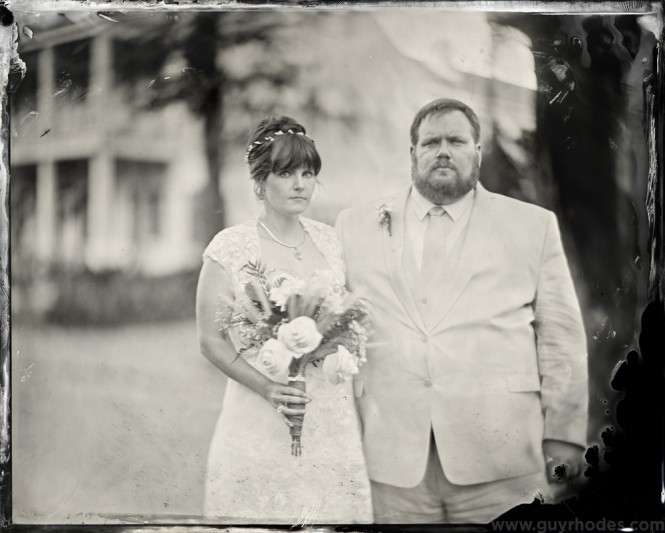Wet Plate Journey
Bronwyn Coffeen and John David Mercer pose for a wet plate collodion portrait on their wedding day in Mobile, Ala., Saturday, July 19, 2014. The 8×10 tintype image was produced using a vintage 1896 view camera with an 1880 brass petzval lens.
The technical journey photography has taken me on over the past twenty years has been nothing short of remarkable. I’ve gone from shooting 35mm film on a Canon AE-1 for the Block Jr. High yearbook, to shooting on my first digital camera in high school that had a whopping 1/3 megapixel (yes, one-third of one megapixel) resolution, to clacking away at ten frames-per-second on the latest Canon 1-series digital bodies. While digital technology has allowed me to obtain images that would have been impossible to capture as cleanly on any other format, there’s something about the digital workflow that lacks soul. I can’t hold 1’s and 0’s in my hand. I can’t accidentally drop and scratch a .jpeg file. I can’t smell a histogram.
Last May, I decided to get back to my roots with learning the process of shooting and developing large-format 4×5 film. I’d hoped that the 4×5 process would free me from the ultra-predictability of the digital world, giving me images rich with flaws (yes, I wanted flaws) and organic errors. To my surprise, I discovered that the Tri-X 320 film I was shooting, once scanned, was actually superior to my digital cameras in terms of resolution and sharpness. As for those flaws I’d hoped for? Well, the film images were pretty technically solid aside from the errant scratch or two from loading my holders.
While spending most of that summer ruminating on why I couldn’t mess up film more, I stumbled upon the wet plate collodion work of photographer Ian Ruhter. The ghostly images Ruhter was capturing, filled with cloudy streaks, lines, and vignettes, were exactly what I was after when I embarked on my 4×5 film foray. Interestingly, the wet plate process wasn’t completely foreign to me. I’d previously seen the work of wet plate photographer Robert Szabo at a civil war reenactment I shot in Gettysburg in 2009. At the time, however, I’d written-off the process as something entirely too complicated and dangerous for me to take on. Seeing Ruhter and his team working in their many videos, however, re-ignited my interest in the format, and I knew immediately it was something I had to learn.
Learning the wet plate collodion process from photographer Thomas Gibson at his studios in Lecompton, Kansas, on October 12, 2013.
Months later, I found myself in the middle of the remote Kansas prairie at the studios of Thomas Gibson for a day-long wet plate workshop. Gibson and his assistant took me through the entire process, from preparing the necessary chemistry from scratch, to shooting and developing plates, to varnishing them for a lifetime or more of enjoyment. Learning the technical caveats (of which there are many) of the process, of course, is something that requires far more practice than a day-long workshop can provide, but the workshop put me far ahead of the many beginner’s mistakes I would have undoubtedly made without that training. Perfecting the process is something that takes many years, and working towards that perfection is what is so fun about the art form.
In a nutshell, wet plate photography is a lot like the 4×5 film photography that led me to it. Light sensitive aluminum or glass plates (which you create on the spot) are exposed in the camera, developed using liquid developer, stopped, fixed, and washed.








